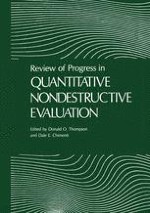1989 | OriginalPaper | Buchkapitel
Finite Element Model of Stress Wave Topology in Unidirectional Graphite/Epoxy: Wave Velocities and Flux Deviations
verfasst von : R. D. Kriz, P. R. Heyliger
Erschienen in: Review of Progress in Quantitative Nondestructive Evaluation
Verlag: Springer US
Enthalten in: Professional Book Archive
Aktivieren Sie unsere intelligente Suche, um passende Fachinhalte oder Patente zu finden.
Wählen Sie Textabschnitte aus um mit Künstlicher Intelligenz passenden Patente zu finden. powered by
Markieren Sie Textabschnitte, um KI-gestützt weitere passende Inhalte zu finden. powered by
Until recently, the use of a finite element model (FEM) to simulate stress wave propagation has been limited to solutions where the number of degrees of freedom are kept to a minimum, because of hardware limitations on computer memory and computational speed. With the advent of a number of new supercomputers, numerical simulation becomes a reasonable approach to some simpler problems. Recently, Ludwig, et. at [1,2] have demonstrated the feasibility of such an approach for problems where materials are either isotropic or only slightly anisotropic. We extend this effort to unidirectional graphite/epoxy which has large variations in elastic properties. For this material the effect of elastic anisotropy on stress wave propagation has been studied both experimentally and analytically [3,4] and several interesting properties have been predicted and measured: mode transitions, sensitivity of flux deviations to small changes in anisotropy, and shear wave speeds exceeding longitudinal waves. With a FEM we can simulate and study some of these properties most effectively.
